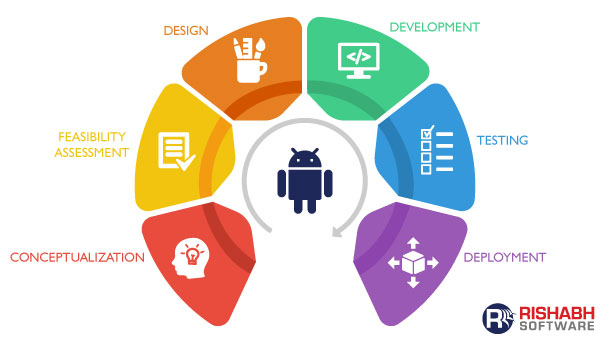As apps become an integral part of our lives, organizations realize the importance to shift to an approach that targets their services across platforms. And, to be perceived as a top player in this segment, it’s crucial to leverage the right methodologies to build a strong and lasting competitive edge. Cross-platform mobile app development is one strategy that helps businesses redefine their approach to achieving rapid digital growth. Wondering why? Let’s find out.
As a cross-platform app development company, we encounter similar queries now and then from our customers. Through this post, we aim to answer multiple facets of how & why cross-platform applications have become a popular choice, their advantages, popular frameworks & also how native & cross-platform development approaches differ.
Let’s dive right in!
Q: What is Cross-Platform Development?
A: It is a development framework that allows teams globally to build mobile applications using a single code base that works across multiple systems. It helps save them time to write native code across each operating system while acquiring new skills to support every mobile device. Further, the reusable code base enables the timely resolution of bugs and includes enhancements on all platforms in one go. This is beyond doing it for each platform separately.
The fast turnaround time, rapid development & high-quality outcomes are some of the reasons that encourage more businesses to take this route.
Q: Why Is Cross-platform Development Important?
A: It enables companies to create low-cost custom applications that are secure, stable and effortless to maintain. They are easier to iterate and hence facilitate faster development cycles with quicker time to market as opposed to traditional app development initiatives.
To put it simpler words; with cross-platform applications you:
- Get wider access to the target audience
- Reduce development costs with a quicker process
- Have easier maintenance
- Have reusable code
- Get Faster time-to-market
We will be discussing them in greater detail below in the advantages of cross-platform development section, so stay with us!
Q: What Are Cross-Platform Applications And Their Types?
A: They are essentially mobile apps that are developed for operating systems like iOS and Android. These apps help address the changing market preferences and shifting loyalties by offering the same consistent footprint across platforms. It is one of the crucial factors for businesses to retain and engage customers.
Types:
Native cross-platform apps: Built using .NET MAUI, React Native, and Kotlin multiplatform capabilities they help create a unified API that runs on top of a native SDK. And by making use of the native IDEs, the development teams can create iOS and Android apps that share the same codebase.
Hybrid apps: The backend of mobile phones is critical since they manage the business logic. As Android and iOS SDK have advanced web components, certain parts of an application including UI can be created using JavaScript, HTML5 and CSS. The development teams wrap the code in WebView (a browser that’s within a mobile app) it renders the content visible. Apache Cordova (formerly known as PhoneGap) and Flutter are some of the popular & promising hybrid app development frameworks available in the marketplace right now. Further, do this blog a read if you wish to learn essential facets of how hybrid app development can help your business with the right approach.
Q: What are the Advantages of Cross-Platform Development?

Reusable code components: As you read above, with a cross-platform development approach, the teams don’t have to write unique code for different platforms. Instead, the program developed for one app gets leveraged many times because of reusable code.
Reduced costs: Offers a quicker turnaround since there is only one app that needs to be developed. And, rather than having to build multiple apps across each platform, which would take a lot of time, with just one single app, there is a significant reduction in both development time and cost. Even the learning curve essentially is not complex. Also, the development teams don’t have to invest time and money in learning multiple technologies. They have to master a few skills to get started with the development process.
Easier maintenance: The maintenance and update of a single app across platforms make it easier for development teams. The seamless synchronization at one go or in the batch of updates across OS helps save a lot of time and money. And, with automated & scheduled releases, the users can expect to have the latest version of the app at all times.
Ability to effectively reach the target audience: It is a given fact that with a cross-platform app, you can expect maximum exposure to your target audience. This allows UX design teams to focus, brainstorm and develop an intuitive design that is accessible & works seamlessly across the board.
Q: What are the Disadvantages of Cross-Platform Development?
A: You would agree with the saying that goes like every bean has its black. And, cross-platform development isn’t an exception. Listed below are few points in this reference;
Performance challenges: Cross-platform apps have integration challenges with their target operating systems. It is because of inconsistent communication between the device’s native and non-native components. It affects the optimum performance of applications.
Slow code performance with limited tool availability: Cross-compliance during the development phase makes the code sluggish at times and even reduces the speed. Also, in certain scenarios, it becomes mandatory for the developers to make use of tools suited to a particular app.
Limited user experience: Cross-platform applications are not able to take total advantage of native-only features to provide excellent user experiences. It is because of different screen layouts, platforms, and functionality.
Q: What are the Popular Cross-Platform Frameworks?
A: As an organization that has worked with various businesses to build cross-platform apps, we’ve learned that Flutter, React Native and .NET MAUI top the list of best frameworks. We’ll break down these terms for you so that you get a better understanding of each framework.
- .NET MAUI: It evolves Xamarin’s core structure with powerful new capabilities for modern app development. MAUI preserves essential native hardware access while delivering superior performance, streamlined architecture, and enhanced UI controls. Our migration specialists can transform your Xamarin applications to MAUI efficiently while maintaining core functionality and enabling next-generation features. We handle technical complexity, so you gain immediate benefits from this platform-agnostic framework.
- React Native: As one of the top cross-platform frameworks by Facebook, this is a best-in-breed JavaScript library that helps with creating powerful user interfaces. With this, you can create mobile apps that reuse their code up to 80% and can also access certain native features like mobile camera and accelerometer.
- Flutter: As Google’s UI toolkit, this framework helps build native compiled apps for smartphones, desktops and web browsers using the same code. Dart, a comparatively new programming language that powers Flutter shares similarities with Swift and Kotlin & can be converted into JavaScript code. It helps design apps that can be built quickly and can be converted to platform-specific UX logic. It’s also most suitable for MVP development.
Q: What is the Difference Between Cross-Platform vs Native Development?
A: Since these technologies are in a constant state of evolution, it’s important to review and compare them to understand the key differences. From a business standpoint though, we believe that it’s important for you to understand the key differences between these processes, which will help you make a more concrete choice.
| Cross-Platform | Native | |
| Multiple platform deployment costs | Cost effective – save up to 80% of project budgets through deployment to other platforms | Higher – as it requires app architecture adoption to deploy the app across multiple platforms |
| Deployment time | Lower – resuable code results in significant reduction in time-to-market | Higher – would require app source creation from scratch across each individual platform |
| Programming expertise | Cross-platform comprises of web-based frameworks that enable easy discovery of talent from the pool of web developers | Usually expensive as the developer’s skills would cost more and difficult to obtain at times |
| App users | Easy promotion of app across different platforms thus targeting a large user audience | Single platform development focus would result in losing 50% of potential app users |
| Design challenges | Development teams would have to add features explicitly | The design process is simplified because of the services and support offered by the OS |
Closing Remarks
With cross-platform app development gaining traction in the mobile app development world, it would be a smarter choice to adopt a mobile-first approach. As it is becoming more effortless by the day, why shouldn’t your organization take advantage of the benefits that help improve business performance?
By getting rid of a cumbersome development process, one can shift their focus toward product innovation to drive value for their customers. It would ultimately augment long-term profits. We hope the points discussed above, provided clarity on what all entails in cross-platform app development.











 30 Min
30 Min


